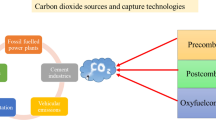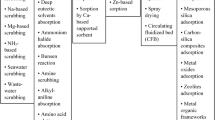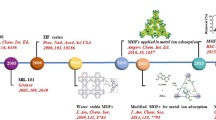Abstract
Desulfurization of natural gas is achieved commercially by absorption with liquid amine solutions. Adsorption technology could potentially replace the solvent extraction process, particularly for the emerging shale gas wells with production rates that are generally lower than that from the large conventional reservoirs, if a superior adsorbent (sorbent) is developed. In this review, we focus our discussion on three types of sorbents: metal-oxide based sorbents, Cu/Ag-based and other commercial sorbents, and amine-grafted silicas. The advantages and disadvantages of each type are analyzed. Possible approaches for future developments to further improve these sorbents are suggested, particularly for the most promising amine-grafted silicas.
Similar content being viewed by others
References
Haring H W. Industrial Gas Processing. Weinheim: Wiley-VCH, 2008, 217–238
George D L, Bowles E C. Shale gas measurement and associated issues. http://www.pipelineandgasjournal.com/shale-gas-measurement-and-associated-issues
Posey M L, Tapperson K G, Rochelle G T. A simple model for prediction of acid gas solubilities in alkanolamines. Gas Separation & Purification, 1996, 10(3): 181–186
Pani F, Gaunand A, Richon D, Cadours R, Bouallou C. Absorption of H2S by an aqueous methyldiethanolamine solution at 296 and 343 K. Journal of Chemical & Engineering Data, 1997, 42(5): 865–870
Kohl A L, Nielsen R. Gas Purification. Houston: Gulf Publishing Company, 1997, 40–186
Kikkinides E S, Sikavitsas V I, Yang R T. Natural gas desulfurization by adsorption: Feasibility and multiplicity of cyclic steady states. Industrial & Engineering Chemistry Research, 1995, 34(1): 255–262
Yang R T. Gas Separation by Adsorption Processes. London: Imperial College Press, 1997, 201–36
Shah V, Quale M. Dow Chemical Company, private communications, June, 2013
Yang R T. Adsorbents: Fundamentals and Applications. New York: Wiley, 2003, 131–156
Huang H Y, Yang R T, Chinn D, Munson C L. Amine grafted MCM-48 and silica xerogel as superior sorbents for acidic gas (H2S and CO2) removal from natural gas. Industrial & Engineering Chemistry Research, 2003, 42(12): 2427–2433
Ma X, Wang X, Song C. Molecular basket sorbents for separation of CO2 and H2S from various gas streams. Journal of the American Chemical Society, 2009, 131(16): 5777–5783
Belmabkhout Y, Weireld G D, Sayari A. Amine-bearing mesoporous silica for CO2 and H2S removal from natural gas and biogas. Langmuir, 2009, 25(23): 13275–13278
Xue Q, Liu Y S. Removal of minor concentration of H2S on MDEA-modified SBA-15 for gas purification. Journal of Industrial and Engineering Chemistry, 2012, 18(1): 169–173
Hunger B, Matysik S, Heuchel M, Geidel E, Toufar H. Adsorption of water on zeolites of different types. Journal of Thermal Analysis, 1997, 49(1): 553–565
Tanada S, Bok K. Adsorption behavior hydrogen sulfide inside micropores of molecular sieve carbon 5A and molecular sieve zeolite 5A. Bulletin of Environmental Contamination and Toxicology, 1982, 29(5): 624–629
Steuten B, Pasel C, Luckas M, Bathen D. Trace level adsorption of toxic sulfur compounds, carbon dioxide, and water from methane. Journal of Chemical & Engineering Data, 2013, 58(9): 2465–2473
Bagreev A, Bandosz T J. Role of sodium hydroxide in the process of hydrogen sulfide adsorption/oxidation on caustic-impregnated activated carbons. Industrial & Engineering Chemistry Research, 2002, 41(4): 672–679
Bagreev A, Bandosz T J. On the mechanism of hydrogen sulfide removal from moist air on catalytic carbonaceous adsorbents. Industrial & Engineering Chemistry Research, 2005, 44(3): 530–538
Chiang H L, Tsai J H, Tsai C L, Hsu Y I C H U N. Adsorption characteristics of alkaline activated carbon exemplified by water vapor, H2S and CH3SH gas. Separation Science and Technology, 2000, 35(6): 903–918
Bandosz T J. On the adsorption/oxidation of hydrogen sulfide on activated carbons at ambient temperatures. Journal of Colloid and Interface Science, 2002, 246(1): 1–20
Hamon L, Serre C, Devic T, Loiseau T, Millange F, Ferey G, Weireld G D. Comparative study of hydrogen sulfide adsorption in the MIL-53(Al, Cr, Fe), MIL-47(V), MIL-100(Cr), and MIL-101 (Cr) metal-organic frameworks at room temperature. Journal of the American Chemical Society, 2009, 131(25): 8775–8777
Li Y, Yang R T. Gas adsorption and storage in metal-organic framework MOF-177. Langmuir, 2007, 23(26): 12937–12944
Wang L, Lachawiec A J Jr, Yang R T. Nanostructured adsorbents for hydrogen storage at ambient temperature: High-pressure measurements and factors influencing hydrogen spillover. RSC Advances, 2013, 3(46): 23935–23952
Han S, Huang Y, Watanabe T, Nair S, Walton K S, Sholl D S, Carson M. MOF stability and gas adsorption as a function of exposure to water, humid air, SO2 and NO2. Microporous and Mesoporous Materials, 2013, 173: 8691
Wang L F, Yang R T. Hydrogen storage on carbon-based adsorbents and storage at ambient temperature by hydrogen spillover. Catalysis Reviews. Science and Engineering, 2010, 52(4): 411461
Westmoreland P R, Harrison D P. Evaluation of candidate solids for high-temperature desulfurization of low-Btu gases. Environmental Science & Technology, 1976, 10(7): 659–661
Xue M, Chitrakar R, Sakane K, Ooi K. Screening of adsorbents for removal of H2S at room temperature. Green Chemistry, 2003, 5(5): 529534
Ko T, Chu H, Chaung L. The sorption of hydrogen sulfide from hot syngas by metal oxides over supports. Chemosphere, 2005, 58(4): 467474
Huang C C, Chen C H, Chu S M. Effect of moisture on H2S adsorption by copper impregnated activated carbon. Journal of Hazardous Materials, 2006, 136(3): 866873
Nguyen-Thanh D, Bandosz T J. Effect of transition-metal cations on the adsorption of H2S in modified pillared clays. Journal of Physical Chemistry B, 2003, 107(24): 5812–5817
Garcia C L, Lercher J A. Adsorption of hydrogen sulfide on ZSM-5 zeolites. Journal of Physical Chemistry, 1992, 96(5): 2230–2235
Gasper-Galvin L, Atimtay A T, Gupta R P. Zeolite-supported metal oxide sorbents for hot-gas desulfurization. Industrial & Engineering Chemistry Research, 1998, 37(10): 4157–4166
Kyotani T, Kawashima H, Tomita A, Palmer A, Furimsky E. Removal of H2S from hot gas in the presence of Cu-containing sorbents. Fuel, 1989, 68(1): 74–79
Montes D, Tocuyo E, González E, Rodríguez D, Solano R, Atencio R, Ramos M A, Moronta A. Solano, Atencio R, Ramos M A, Moronta A. Reactive H2S chemisorption on mesoporous silica molecular sieve-supported CuO or ZnO. Microporous and Mesoporous Materials, 2013, 168: 111–120
Ayala R E, Marsh D W. Characterization and long-range reactivity of zinc ferrite in high-temperature desulfurization processes. Industrial & Engineering Chemistry Research, 1991, 30(1): 55–60
Baird T, Denny P J, Hoyle R, Mcmonagle F, Stirling D, Tweedy J. Modified zinc-oxide absorbents for low-temperature gas desulfurization. Journal of the Chemical Society, Faraday Transactions, 1992, 88(22): 3375–3382
Gasper-Galvin L, Atimtay A T, Gupta R P. Zeolite-supported metal oxide sorbents for hot-gas desulfurization. Industrial & Engineering Chemistry Research, 1998, 37(10): 4157–4166
Polychronopoulou K, Fierro J L G, Efstathiou A M. Novel Zn-Ti-based mixed metal oxides for low-temperature adsorption of H2S from industrial gas streams. Applied Catalysis B: Environmental, 2005, 57(2): 125–137
Yang H Y, Tatarchuk B. Novel-doped zinc oxide sorbents for low temperature regenerable desulfurization applications. AIChE Journal. American Institute of Chemical Engineers, 2010, 56(11): 2898–2904
Israelson G. Results of testing various natural gas desulfurization adsorbents. Journal of Materials Engineering and Performance, 2004, 13(3): 282–286
King D L, Birnbaum J C, Singh P. Sulfur removal from pipeline natural gas fuel: Application to fuel cell power generation systems. Pacific Northwest National Laboratory. Fuel Cell Seminar, Palm Springs, CA, November 18–21, 2002
Satokawa S, Kobayashi Y, Fujiki H. Adsorptive removal of dimethylsulfide and t-butylmercaptan from pipeline natural gas fuel on Ag zeolites under ambient conditions. Applied Catalysis B: Environmental, 2005, 56(1–2): 51–56
Alptekin G O. Sorbents for desulfurization of natural gas, LPG and transportation Fuels. Sixth Annual SECA Workshop, Pacific Grove, CA, April 21, 2004
Crespo D, Qi G, Wang Y, Yang F H, Yang R T. Superior sorbent for natural gas desulfurization. Industrial & Engineering Chemistry Research, 2008, 47(4): 1238–1244
Lasperas M, Llorett T, Chaves L, Rodriguez I, Cauvel A, Brunel D. Amine functions linked to MCM-41-type silicas as a new class of solid base catalysts for condensation reactions. Studies in Surface Science and Catalysis, 1997, 108: 75–82
Angeletti E, Canepa C, Martinetti G, Venturello P. Silica gel functionalized with amino groups as a new catalyst for Knoevenagel condensation under heterogeneous catalysis conditions. Tetrahedron Letters, 1988, 29(18): 2261–2264
Burwell R L, Leal O. Modified silica-gels as selective adsorbents for sulfur-dioxide. Journal of the Chemical Society. Chemical Communications, 1974, 9(9): 342–343
Leal O, Bolivar C, Ovalles C, Garcia J J, Espidel Y. Reversible adsorption of carbon dioxide on amine surface-bonded silica gel. Inorganica Chimica Acta, 1995, 240(1–2): 183–189
Choi S H, Drese J H, Jones C W. Adsorbent materials for CO2 capture from large anthropogenic point sources. ChemSusChem, 2009, 2(9): 796–854
D’Alessandro D M, Smit B, Long J R. Carbon dioxide capture: Prospect for new materials. Angewandte Chemie International Edition, 2010, 49(35): 6058–6082
Bollini P, Didas S A, Jones C W. Amine-oxide hybrid materials for acid gas separations. Journal of Materials Chemistry, 2011, 21(39): 15100–15120
Samanta A, Zhao A, Shimazu G K H, Sarkar P, Gupta R. Post-combustion CO2 capture using solid sorbents: A review. Industrial & Engineering Chemistry Research, 2012, 51(4): 1438–1463
Beck J S, Vartuli J C, Roth W J, Leonowicz M E, Kresge C T, Schmitt K D, Chu C T W, Olson D H, Sheppard E W, McCullen S B, Higgins J B, Schlenker J L. A new family of mesoporous molecular-sieves prepared with liquid-crystal templates. Journal of the American Chemical Society, 1992, 114(27): 10834–10843
Kresge C T, Leonowicz M E, Roth W J, Vartuli J C, Beck J S. Ordered mesoporous molecular-sieves synthesized by a liquid-crystal template mechanism. Nature, 1992, 359(6397): 710–712
Sayari A, Yang Y, Kruk M, Jaroniec M. Expanding the pore size of MCM-41 silicas: Use of amines as expanders in direct synthesis and postsynthesis procedures. Journal of Physical Chemistry B, 1999, 103(18): 3651–3658
Chen Q, Fan F, Long D, Liu X, Liang X, Qiao W, Ling L. Poly (ethyleneimine)-loaded silica monolith with a hierarchical pore structure for H2S adsorptive removal. Industrial & Engineering Chemistry Research, 2010, 49(22): 11408–11414
Wang L, Yang R T. Increasing selective CO2 adsorption on amine-grafted SBA-15 by increasing silanol density. Journal of Physical Chemistry C, 2011, 115(43): 21264–21272
Zhuravlev L T. Surface characterization of amorphous silica—A review of work from the former USSR. Colloids and Surfaces A: Physicochemical and Engineering Aspects, 1993, 74(1): 71–90
Perry J B. Infrared study of OH and NH2 groups on the surface of a dry silica aero-gel. 1966. Journal of Physical Chemistry, 1966, 70(9): 2937–2945
Zhuravlev L T. The surface chemistry of amorphous silica. Zhuravlev model. Colloids and Surfaces A: Physicochemical and Engineering Aspects, 2000, 173(1–3): 1–38
Zhao D Y, Feng J L, Huo Q S, Melosh N, Fredrickson G H, Chemelka B F, Stucky G D. Triblock copolymer syntheses of mesoporous silica with periodic 50 to 300 angstrom pores. Science, 1998, 279(5350): 548–552
Cassiers K, Van Der Voort P, Vansant E F. Synthesis of stable and directly usable hexagonal mesoporous silica by efficient amine extraction in acidified water. Chemical Communications, 2000, 24(24): 2489–2490
Tian B Z, Liu X Y, Yu C Z, Gao F, Luo Q, Xie S H, Tu B, Zhao D Y. Microwave assisted template removal of siliceous porous materials. Chemical Communications, 2002, 11(11): 1186–1187
Author information
Authors and Affiliations
Corresponding author
Rights and permissions
About this article
Cite this article
Wang, L., Yang, R.T. New nanostructured sorbents for desulfurization of natural gas. Front. Chem. Sci. Eng. 8, 8–19 (2014). https://doi.org/10.1007/s11705-014-1411-4
Received:
Accepted:
Published:
Issue Date:
DOI: https://doi.org/10.1007/s11705-014-1411-4




